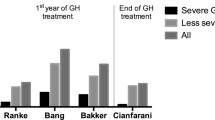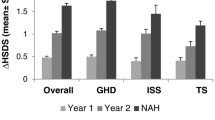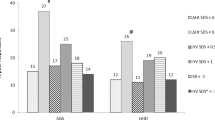Abstract
Purpose
We aimed to evaluate the near-final height (nFHt) in a large cohort of pediatricpatients with growth hormone deficiency (GHD) and to elaborate a new predictive method of nFHt.
Methods
We recruited GHD patients diagnosed between 1987 and 2014 and followed-up until nFHt. To predict the values of nFHt, each predictor was run in a univariable spline.
Results
We enrolled 1051 patients. Pre-treatment height was −2.43 SDS, lower than parental height (THt) (−1.09 SDS, p < 0.001). The dose of recombinant human GH (rhGH) was 0.21mg/kg/week at start of treatment. nFHt was −1.08 SDS (height gain 1.27 SDS), higher than pre-treatment height (p < 0.001) and comparable to THt. 1.6% of the patients were shorter than −2 SDS from THt. The rhGH dose at nFHt was 0.19 mg/kg/week, lower than at the start (p < 0.001). The polynomial regression showed that nFHt was affected by gender, THt, age at puberty, height at puberty, age at the end of treatment (F = 325.37, p < 0.0001, R2 87.2%).
Conclusion
This large national study shows that GHD children can reach their THt. The rhGH/kg/day dose significantly decreased from the start to the end of the treatment. Our model suggests the importance of a timely diagnosis, possibly before puberty, the beneficial effect of long-term treatment with rhGH, and the key-role of THt. Our prediction model has a very acceptable error compared to the majority of other published studies.

Similar content being viewed by others
References
Backeljauw P, Cappa M, Kiess W et al (2021) Impact of short stature on quality of life: a systematic literature review. Growth Horm IGF Res 57–58:101392. https://doi.org/10.1016/j.ghir.2021.101392
Gardner M, Boshart ML, Yeguez CE, Desai KM, Sandberg DE (2016) Coming up short: risks of bias in assessing psychological outcomes in growth hormone therapy for short stature. J Clin Endocrinol Metab 101:23–30. https://doi.org/10.1210/jc.2015-3256
Growth Hormone Research Society (2000) Consensus guidelines for the diagnosis and treatment of growth hormone (GH) deficiency in childhood and adolescence: summary statement of the GH research society. J Clin Endocrinol Metab 85:3990–3993. https://doi.org/10.1210/jcem.85.11.6984
Grimberg A, DiVall SA, Polychronakos C et al (2016) Guidelines for growth hormone and insulin-like growth factor-I treatment in children and adolescents: growth hormone deficiency, idiopathic short stature, and primary insulin-like growth factor-I deficiency. Horm Res Paediatr 86(6):361–397. https://doi.org/10.1159/000452150
Demiral M, Unal E, Baysal B, Baran RT, Demirbilek H, Özbek MN (2020) Evaluation of the final adult height and its determinants in patients with growth hormone deficiency: a single-centre experience from the south-eastern region of Turkey. J Clin Res Pediatr Endocrinol 12:295–302. https://doi.org/10.4274/jcrpe.galenos.2020.2019.0218
Kurnaz E, Çetinkaya S, Aycan Z (2018) Near final height in patients with idiopathic growth hormone deficiency: a single-centre experience. J Paediatr Child Health 54:1221–1226. https://doi.org/10.1111/jpc.14061
Yordam N, Kandemir N, Alikaşifoğlu A (1998) The results of long-term growth hormone replacement therapy in Turkish children with growth hormone deficiency. Turk J Pediatr 40:55–60
Cappa M, Iughetti L, Loche S, Maghnie M, Vottero A, GeNeSIS National Board on behalf of the GeNeSIS Italian Investigators (2016) Efficacy and safety of growth hormone treatment in children with short stature: the Italian cohort of the GeNeSIS clinical study. J Endocrinol Invest 39:667–677. https://doi.org/10.1007/s40618-015-0418-0
Rachmiel M, Rota V, Atenafu E, Daneman D, Hamilton J (2007) Final height in children with idiopathic growth hormone deficiency treated with a fixed dose of recombinant growth hormone. Horm Res 68:236–243. https://doi.org/10.1159/000101427
Straetemans S, De Schepper J, Thomas M, Verlinde F, Rooman R, BESPEED (2016) Validation of prediction models for near adult height in children with idiopathic growth hormone deficiency treated with growth hormone: a Belgian registry study. Horm Res Paediatr 86:161–168. https://doi.org/10.1159/000448553
Thomas M, Massa G, Bourguignon JP et al (2001) Final height in children with idiopathic growth hormone deficiency treated with recombinant human growth hormone: the Belgian experience. Horm Res 55:88–94. https://doi.org/10.1159/000049976
Carel JC, Ecosse E, Nicolino M et al (2002) Adult height after long term treatment with recombinant growth hormone for idiopathic isolated growth hormone deficiency: observational follow up study of the French population based registry. BMJ 325(7355):70. https://doi.org/10.1136/bmj.325.7355.70
Reiter EO, Price DA, Wilton P, Albertsson-Wikland K, Ranke MB (2006) Effect of growth hormone (GH) treatment on the near-final height of 1258 patients with idiopathic GH deficiency: analysis of a large international database. J Clin Endocrinol Metab 91:2047–2054. https://doi.org/10.1210/jc.2005-2284
Darendeliler F, Lindberg A, Wilton P (2011) Response to growth hormone treatment in isolated growth hormone deficiency versus multiple pituitary hormone deficiency. Horm Res Paediatr 76:42–46. https://doi.org/10.1159/000329161
Hartmann K, Ittner J, Müller-Rossberg E et al (2013) Growth hormone treatment adherence in prepubertal and pubertal children with different growth disorders. Horm Res Paediatr 80:1–5. https://doi.org/10.1159/000351800
Coelho R, Brook CG, Preece MA, Stanhope RG, Dattani MT, Hindmarsh PC (2008) A randomised study of two doses of biosynthetic human growth hormone on final height of pubertal children with growth hormone deficiency. Horm Res 70:85–88. https://doi.org/10.1159/000139149
Smyczyńska U, Smyczyńska J, Hilczer M, Stawerska R, Tadeusiewicz R, Lewiński A (2018) Pre-treatment growth and IGF-I deficiency as main predictors of response to growth hormone therapy in neural models. Endocr Connect 7:239–249. https://doi.org/10.1530/EC-17-0277
Polak M, Blair J, Kotnik P, Pournara E, Pedersen PT, Rohrer TR (2017) Early growth hormone treatment start in childhood growth hormone deficiency improves near adult height: analysis from NordiNet® international outcome study. Eur J Endocrinol 177:421–429. https://doi.org/10.1530/EJE-16-1024
Migliaretti G, Ditaranto S, Guiot C et al (2018) Long-term response to recombinant human growth hormone treatment: a new predictive mathematical method. J Endocrinol Invest 41:839–848. https://doi.org/10.1007/s40618-017-0816-6
Villafuerte B, Barrio R, Martín-Frías M, Alonso M, Roldán B (2019) Auxological characteristics of pediatric patients with permanent or transient isolated growth hormone deficiency. Response to treatment and final height. Endocrinol Diabetes Nutr (Engl Ed) 66:368–375. https://doi.org/10.1016/j.endinu.2018.11.007
Pozzobon G, Partenope C, Mora S, Garbetta G, Weber G, Barera G (2019) Growth hormone therapy in children: predictive factors and short-term and long-term response criteria. Endocrine 66:614–621. https://doi.org/10.1007/s12020-019-02057-x
Ranke MB, Lindberg A, Brosz M et al (2012) Accurate long-term prediction of height during the first four years of growth hormone treatment in prepubertal children with growth hormone deficiency or turner syndrome. Horm Res Paediatr 78:8–17. https://doi.org/10.1159/000339468
Schönau E, Westermann F, Rauch F et al (2001) A new and accurate prediction model for growth response to growth hormone treatment in children with growth hormone deficiency. Eur J Endocrinol 144:13–20. https://doi.org/10.1530/eje.0.1440013
Coste J, Letrait M, Carel JC et al (1997) Long-term results of growth hormone treatment in France in children of short stature: population, register based study. BMJ 315:708–713. https://doi.org/10.1136/bmj.315.7110.708
Ranke MB, Lindberg A, Tanaka T et al (2017) Baseline characteristics and gender differences in prepubertal children treated with growth hormone in Europe, USA, and Japan: 25 Years’ KIGS® experience (1987–2012) and review. Horm Res Paediatr 87:30–41. https://doi.org/10.1159/000452887
Carrascosa A, Audí L, Bosch-Castañé J et al (2008) Influencia de la edad de inicio del brote de crecimiento puberal en la talla adulta [Influence of the age at the start of pubertal growth on adult height]. Med Clin 130:645–649. https://doi.org/10.1157/13120692
Westphal O, Lindberg A, Swedish KIGS National Board (2008) Final height in Swedish children with idiopathic growth hormone deficiency enrolled in KIGS treated optimally with growth hormone. Acta Paediatr 97:1698–1706. https://doi.org/10.1111/j.1651-2227.2008.01053.x
Bakker B, Frane J, Anhalt H, Lippe B, Rosenfeld RG (2008) Height velocity targets from the national cooperative growth study for first-year growth hormone responses in short children. J Clin Endocrinol Metab 93:352–357. https://doi.org/10.1210/jc.2007-1581
Blanco-López A, Antillón-Ferreira C, Saavedra-Castillo E et al (2020) Adherence to treatment in children with growth hormone deficiency, small for gestational age and turner syndrome in Mexico: results of the Easypod™ connect observational study (ECOS). J Endocrinol Invest 43(10):1447–1452. https://doi.org/10.1007/s40618-020-01218-4
Smyczyńska J, Stawerska R, Hilczer M, Lewiński A (2015) Secondary IGF-I deficiency as a prognostic factor of growth hormone (GH) therapy effectiveness in children with isolated, non-acquired GH deficiency. Exp Clin Endocrinol Diabetes 123:209–214. https://doi.org/10.1055/s-0034-1395665
Ranke MB, Martin DD, Lindberg A (2003) Prediction model of total pubertal growth in idiopathic growth hormone deficiency: analysis of data from KIGS. Horm Res 60(Suppl 1):58–59. https://doi.org/10.1159/000071227
Dahlgren J, Kriström B, Niklasson A, Nierop AF, Rosberg S, Albertsson-Wikland K (2007) Models predicting the growth response to growth hormone treatment in short children independent of GH status, birth size and gestational age. BMC Med Inform Decis Mak 7:40. https://doi.org/10.1186/1472-6947-7-40
Albertsson-Wikland K, Kriström B, Lundberg E et al (2014) Growth hormone dose-dependent pubertal growth: a randomized trial in short children with low growth hormone secretion. Horm Res Paediatr 82:158–170. https://doi.org/10.1159/000363106
Straetemans S, De Schepper J, Thomas M, Tenoutasse S, Beauloye V, Rooman R (2019) Criteria for first-year growth response to growth hormone treatment in prepubertal children with growth hormone deficiency: do they predict poor adult height outcome? Front Endocrinol (Lausanne) 10:792. https://doi.org/10.3389/fendo.2019.00792
Straetemans S, Rooman R, De Schepper J (2021) Is a two-year growth response to growth hormone treatment a better predictor of poor adult height outcome than a first-year growth response in prepubertal children with growth hormone deficiency? Front Endocrinol (Lausanne) 12:678094. https://doi.org/10.3389/fendo.2021.678094
Borghi E, de Onis M, Garza C et al (2006) Construction of the world health organization child growth standards: selection of methods for attained growth curves. Stat Med 25(2):247–265. https://doi.org/10.1002/sim.2227 (Erratum.In:StatMed2008; 27(16):3216)
Murray PG, Dattani MT, Clayton PE (2016) Controversies in the diagnosis and management of growth hormone deficiency in childhood and adolescence. Arch Dis Child 101(1):96–100. https://doi.org/10.1136/archdischild-2014-307228
Maciel J, Dias D, Cavaco D, Donato S, Pereira MC, Simões-Pereira J (2021) Growth hormone deficiency and other endocrinopathies after childhood brain tumors: results from a close follow-up in a cohort of 242 patients. J Endocrinol Invest 44(11):2367–2374. https://doi.org/10.1007/s40618-021-01541-4
Acknowledgements
The Members of the Study Group on Physiopathology of growth processes of ISPED are as follows: Bruzzi Patrizia (Modena), Capalbo Donatella (Napoli), Fatti Letizia Maria (Milano) (0000-0002-1219-8953), Luongo Caterina (Napoli), Moro Mirella (Milano) (0000-0003-1645-547X), Pellegrin Maria Chiara (Trieste), Pepe Giorgia (Messina), Predieri Barbara (Modena), Sangiorgio Arianna (Milnao), Salvatoni Alessandro (Varese), Sartori Chiara (Reggio Emilia), Timpanaro Tiziana (Catania), Trombatore Jessica (Messina), Zucchini Stefano (Bologna), Zuccotti Gianvincenzo (Milano). The listed members are considered as authors of the paper.
Author information
Authors and Affiliations
Consortia
Corresponding author
Ethics declarations
Conflict of interest
None to declare. We would like to thank patients and their parents for joining the study.
Additional information
Publisher's Note
Springer Nature remains neutral with regard to jurisdictional claims in published maps and institutional affiliations.
Members of the Study Group on Physiopathology of growth processes of ISPED are listed in the acknowledgements section.
Supplementary Information
Below is the link to the electronic supplementary material.
40618_2022_1808_MOESM1_ESM.pptx
Supplementary file1 Scatter plot and linear trend line to shown relation between real values and estimated values by validation process to predict final height (PPTX 62 KB)
40618_2022_1808_MOESM2_ESM.pptx
Supplementary file2 Scatter plot and linear trend line to shown relation between real values and estimated values by validation process to predict final SDS (PPTX 56 KB)
Rights and permissions
About this article
Cite this article
Lonero, A., Giotta, M., Guerrini, G. et al. Isolated childhood growth hormone deficiency: a 30-year experience on final height and a new prediction model. J Endocrinol Invest 45, 1709–1717 (2022). https://doi.org/10.1007/s40618-022-01808-4
Received:
Accepted:
Published:
Issue Date:
DOI: https://doi.org/10.1007/s40618-022-01808-4




